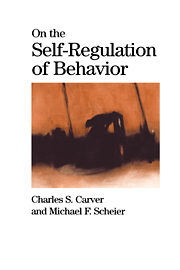Book contents
- Frontmatter
- Contents
- Preface
- Acknowledgments
- 1 Introduction and Plan
- 2 Principles of Feedback Control
- 3 Discrepancy-Reducing Feedback Processes in Behavior
- 4 Discrepancy-Enlarging Loops, and Three Further Issues
- 5 Goals and Behavior
- 6 Goals, Hierarchicality, and Behavior: Further Issues
- 7 Public and Private Aspects of the Self
- 8 Control Processes and Affect
- 9 Affect: Issues and Comparisons
- 10 Expectancies and Disengagement
- 11 Disengagement: Issues and Comparisons
- 12 Applications to Problems in Living
- 13 Hierarchicality and Problems in Living
- 14 Chaos and Dynamic Systems
- 15 Catastrophe Theory
- 16 Further Applications to Problems in Living
- 17 Is Behavior Controlled or Does It Emerge?
- 18 Goal Engagement, Life, and Death
- References
- Name Index
- Subject Index
2 - Principles of Feedback Control
Published online by Cambridge University Press: 05 June 2012
- Frontmatter
- Contents
- Preface
- Acknowledgments
- 1 Introduction and Plan
- 2 Principles of Feedback Control
- 3 Discrepancy-Reducing Feedback Processes in Behavior
- 4 Discrepancy-Enlarging Loops, and Three Further Issues
- 5 Goals and Behavior
- 6 Goals, Hierarchicality, and Behavior: Further Issues
- 7 Public and Private Aspects of the Self
- 8 Control Processes and Affect
- 9 Affect: Issues and Comparisons
- 10 Expectancies and Disengagement
- 11 Disengagement: Issues and Comparisons
- 12 Applications to Problems in Living
- 13 Hierarchicality and Problems in Living
- 14 Chaos and Dynamic Systems
- 15 Catastrophe Theory
- 16 Further Applications to Problems in Living
- 17 Is Behavior Controlled or Does It Emerge?
- 18 Goal Engagement, Life, and Death
- References
- Name Index
- Subject Index
Summary
This chapter describes a set of basic principles underlying the conceptual analysis presented in the remainder of the book. We describe the principles here abstractly, with examples and illustrations taken mostly from domains other than personality–social psychology. Our goal is to create a clear sense of the nature of particular processes (for a more detailed account see Clark, 1996) without pressing the argument that human behavior embodies them. We move on to that argument in due course.
CYBERNETICS, FEEDBACK, AND CONTROL
Wiener (1948) defined cybernetics as the science of communication and control. Cybernetics is one of several terms intertwined with one another – terms such as control processes, feedback processes, and servomechanisms (or servos). These terms have varying origins, they're used preferentially by different people in different lines of work, and they differ in shades of meaning. For our purposes, though, they refer to roughly the same things. Cybernetics is the science of feedback processes; feedback processes involve the control or regulation of certain values within a system (see also Ashby, 1961; Clark, 1996).
Negative Feedback
A negative feedback loop, the basic unit of cybernetic control, is a system of four elements in a particular kind of organization. The elements are an input function, a reference value, a comparator, and an output function (Figure 2.1). An input function is a sensor. It brings information into the loop. In later discussions we'll treat this input function as equivalent to perception.
- Type
- Chapter
- Information
- On the Self-Regulation of Behavior , pp. 10 - 28Publisher: Cambridge University PressPrint publication year: 1998
- 2
- Cited by



